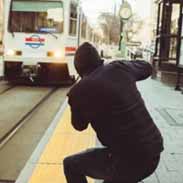Art History Midterm 2710 Clark UVU – Flashcards
Unlock all answers in this set
Unlock answersquestion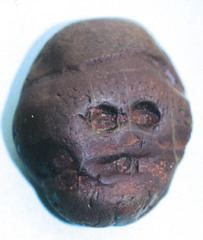
Makapansgat Pebble, PALEOLITHIC, jasperite, South Africa

answer
carried far from original point of origin. Is it a face? First art object? Is it art because we made it? or is it art because we attach meaning and significance to it?
question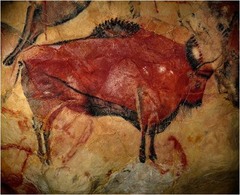
Bison, Altamira Cave, PALEOLITHIC, wall-painting, Spain

answer
(profile representation: horns, legs tail etc. are all clearly visible)...Hunting Ritual, strike marks, symbolically killing the animal, renewing it by painting it and then striking it again-LIKENESS AND PRESENCE (looks like vs. meant to convey the essence), the power of imagery
question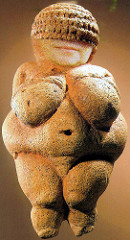
Venus of Willendorf, PALEOLITHIC, limes (boobs look like limes) tone, Kunsthistoriches, Vienna, Austria

answer
Symbol of Fertility (more PRESENCE than it is likeness, artists did not aim for naturalism)
question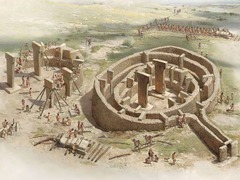
Gobekli Tepe, NEOLITHIC, limestone, Turkey

answer
World's oldest stone temples, carved with animal relief's on T-monoliths (10-12 tons) (Anthropomorphic?: the attribution of human traits, emotions, or intentions to non-human entities) Relief Carving Shrines/Temples No evidence of agrarian activity Hunter-gatherers, All bone/trash deposits are of wild non-domesticated animals, All depictions are of wild animals Religious activity preceded Agriculture
question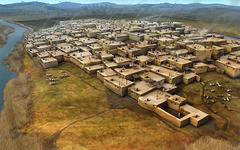
Çatal Huyuk, NEOLITHIC, mud (cattle poop) brick & plaster, Turkey

answer
(complex, record keeping, agrarian), Communal Living, Common Walls, Defensive - Mud-brick construction , Courtyards, Community Shrines, regular appearance of humans in paintings (profile face, forward chest), they prepared the canvas for painting with white plaster
question
Landscape with Town and Volcanic Eruption, NEOLITHIC, Çatal Huyuk, Turkey

answer
First History / Landscape Painting?
question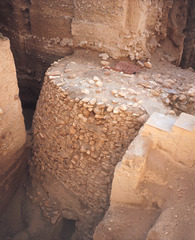
Watch Tower, NEOLITHIC, stone, Jericho

answer
Oldest continuously inhabited town, Defensive Structure
question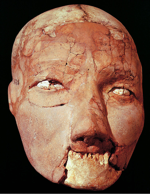
Plastered Skull, NEOLITHIC, plaster, skull, Jericho

answer
FIRST physical portrait gallery. May have "worshipped" their ancestors, life-life "portraits", inlaid with sea shells for eyes, ritualistic
question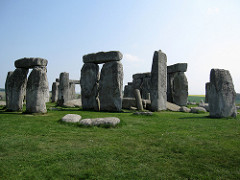
Stonehenge, NEOTLITHIC, sarsen sandstone, Salisbury Plain, England

answer
"Post and Lintel" construction, Megalithic, trilithons (3 stone contruction) , was a funeral site and later an astronomical calendar
question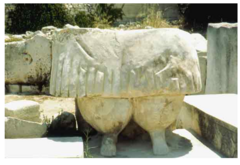
Mother Goddess, NEOLITHIC, limestone, Tarxien Malta

answer
Monumental Sculpture, Fertility Goddess?, Central Cult Worship
question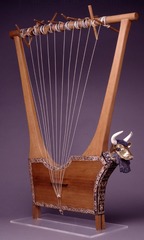
Bull-Headed Lyre, ANCIENT NEAR EAST BRONZE AGE, gold, silver, shell & lapis lazuli over wood, British Museum, London

answer
Royal Tombs of Ur
question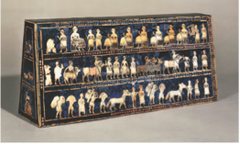
Standard, ANCIENT NEAR EAST BRONZE AGE, gold, silver, shell & lapis lazuli over wood, British Museum, London

answer
Sumerian people, Royal Tombs of Ur, may have been the sound box of an instrument, or a military standard, war side and peace side, divided by three horizontal bands, reads from bottom to top
question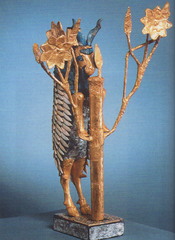
Ram in thicket, ANCIENT NEAR EAST BRONZE AGE, gold, silver, shell & lapis lazuli over wood, British Museum, London

answer
Royal Tombs of Ur, incense burner
question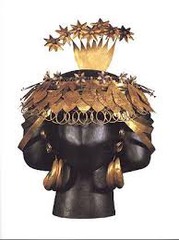
Headdress of Queen Puabi, ANCIENT NEAR EAST BRONZE AGE, Philadelphia

answer
Royal Tombs of Ur, was possibly a queen or moon goddess?
question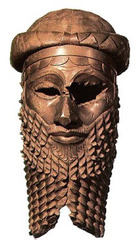
Head of Akkadian Ruler (Sargon), from Nineveh, ANCIENT NEAR EAST BRONZE AGE, cast copper, Baghdad

answer
Mesopotamian people, Akkadian language, great combination of realism and style, *WAX MOLD METHOD!
question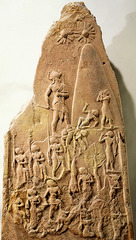
Stele of Naram-Sin (Grandson of Sargon), (from iran) ANCIENT NEAR EAST BRONZE AGE, Louvre, Paris

answer
treading on enemies, bigger and stronger, hierarchy of scale
question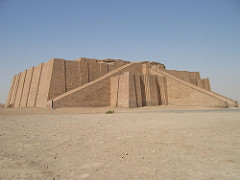
Ziggurat of Ur-Nammu showing main stair. ANCIENT NEAR EAST BRONZE AGE, mudbrick & fired brick, Ur

answer
The oldest preserved tiered temple. higher up represents holier (because they don't have mountains)
question
Stele of Hammurabi, ANCIENT NEAR EAST BRONZE AGE, diorite, Louvre, Paris

answer
Babylonian King established 300 laws for his people, only laws known in great detail, iconography of features that represents that he is a god, it comes not from him but through him...projection of power and where he gets his authority from
question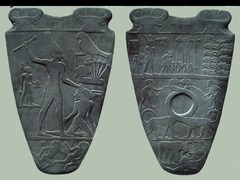
Narmer Palette, Early Dynastic, siltstone, Cairo

answer
UNIFICATION: Narmer, Symbols of Upper and Lower Egypt, projections of power (foreshortening: representing object at angle, instead of frontally or profile)
question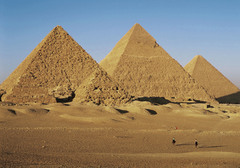
Great Pyramids of Giza, 4th Dynasty, limestone, Giza, Egypt

answer
3 to serve as tombs for the kings of the 4th dynasty: Khufu, Khafre, and Menkaure. Symbolize sunrays. afterlife..the ka (life force) and ba (which goes on to after life)...have to take care of the ka...the pharaoh gets a bigger tomb than anyone...guarded by great sphinx, represents divine presence, a lion with a human head.
question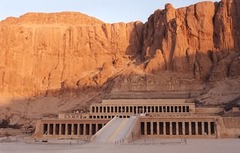
Funerary Temple of Hatshepsut, 18th Dynasty, limestone, Deir El-Bahri, Egypt

answer
(think 18 pillars) female pharaoh, takes on male identity
question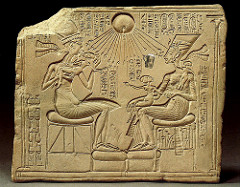
Akhenaten ; family, New Kingdom, 18th Dyn, Berlin

answer
Sunken Relief** less subject to be damaged, mood is casual, features more elongated and curved...tenderness with children, naturalism
question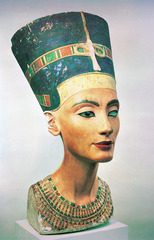
Queen Nefertiti, 18th Dyn., stucco over limestone, Berlin

answer
shift in style, detail
question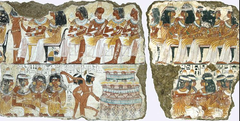
Tomb of Nebamun, 18th Dyn., wall-painting, Thebes, Egypt (Now in London)

answer
Banquet ; Dancers, Artist experimented with frontal views
question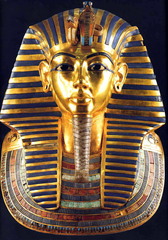
Golden mask of Tutankhamen, 18th Dyn, gold, Cairo

answer
the mask is meant to give him permanent flesh that will last for all time, Heir of Ahkenaten, Restored worship of Egyptian deities, Died at age 18 • Buried in the Valley of the Kings, Tomb concealed by the construction of the tomb of the Rameses IV
question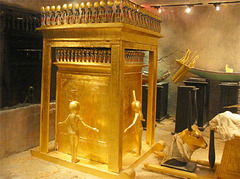
Canopic Shrine with Selket, 18th Dynasty, Egyptian Museum, Cairo

answer
The liver, lungs, stomach, and intestines of the pharaohs were each removed and carefully placed in individual canopic jars
question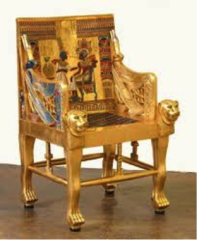
Golden Throne ; Detail of Scene, Tomb of Tutankhamen, 18th Dyn., Egyptian Museum, Cairo

answer
made of wood and covered in gold
question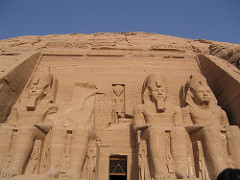
Temple of Abu Simbel, 19th Dyn, sandstone , Nubia, Egypt

answer
Rock- cut temple of Ramses II, resting against a new artificial mountain, 4 huge images of himself, lacking detail because of monumental size
question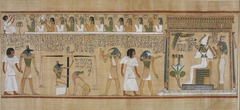
The Book of the Dead of Hunefer, 19th Dyn., British Museum, London

answer
everyone has access to similar after life: Anubis leads him into the hall of judgement, Anubis weighs his heart against a feather, The Ammit will devour the heart if the scales judge him unfavorably, After being justified he is let to the green god Osiris and his sisters to receive eternal life.
question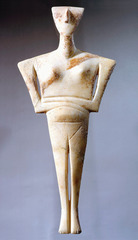
1. Cycladic Figurine, BRONZE AGE AEGEAN marble, National Archaeological Museum, Athens

answer
fertility symbols?
question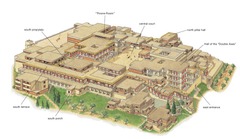
Reconstruction of Knossos (plan) Palace, BRONZE AGE AEGEAN, Crete

answer
where minotaur myth came from...Palace Complexes - Central Courtyards (Ceremonial Centers?) - Magazines Food Storage / Tribute - Residence - Shrines - No obvious walls or fortifications, minoans...shrines, courtyards, palace, frescos...bull leaping seems to be a ceremony, influenced by egyptian but organic...
question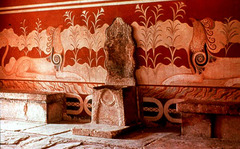
Throne room, Palace of Knossos, BRONZE AGE AEGEAN, Crete

answer
showing gypsum throne ; griffin ; lilies
question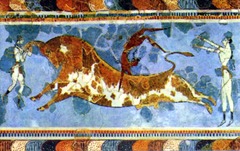
Toreador Fresco, Palace of Knossos, BRONZE AGE AEGEAN, Crete

answer
Men and women, minotaur myth?
question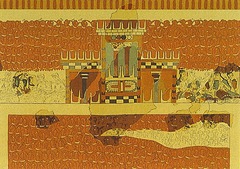
Grandstand Fresco, Palace of knossos, BRONZE AGE AEGEAN, Crete

answer
Olympic games?
question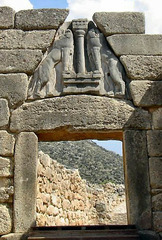
Lion Gate, 2nd Palace Period, BRONZE AGE AEGEAN, Athens

answer
Posts and Lintel*** militaristic...more structure in the art, symmetry...shaft graves..mask of agamemnon, preserving the flesh ...
question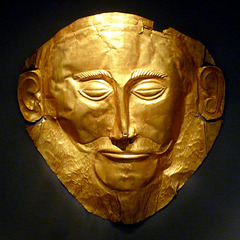
Golden Mask of Agamemnon ; Mycenaean daggers from shaft graves,) c. 1600 BCE, National Archaeological Museum, Athens, BRONZE AGE AEGEAN

answer
first mask in GREECE, produced by metal working with gold
question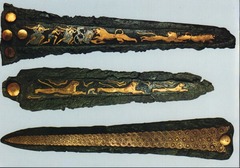
Mycenaean daggers from shaft graves, Mycenae, c. 1600 BCE, National Archaeological Museum , Athens

answer
found in grave circle A, lions attacking a hunter, minoan in style but there were no lions at this date
question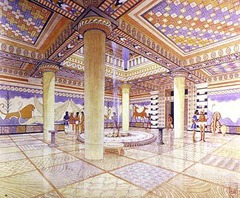
Megaron, Palace of Nestor, BRONZE AGE AEGEAN stone ; plaster, Pylos, Greece

answer
unique architecture, -Throne Room -Axial Orientation -Central Hearth -Throne
question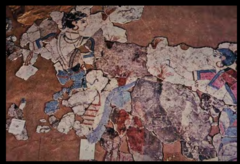
Xeste 3, BRONZE AGE AEGEAN, wall-painting, Akrotiri, Thera

answer
"a seated goddess", saffron gatherers, Crocus / Saffron Gathering - Seasonal / Spice? - Offering? - Medicine? • Women of Varying Maturity - Puberty - Menstruation - Menopause
question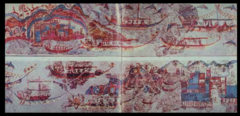
Miniature Frieze, West House, BRONZE AGE AEGEAN, wall-painting, Thera

answer
sea peoples... move into iron age
question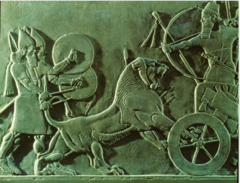
Lion Hunt, NW Palace, IRON AGE NEAR EASTERN, from Nimrod, Iraq, (British Museum)

answer
militaristic
question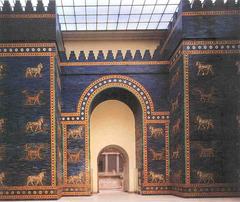
Ishtar Gate from Babylon, IRON AGE NEAR EASTERN, glazed brick and tile, Staatliche Museen, Berlin

answer
known for beautiful blue, amazing use of ceramic tiles. lions, babylonians...militaristic...ishtar gate, sacred animals, - Goddess of Love / War / Art ; Music - Main Entrance to Babylon - Glazed Brick ; Tile
question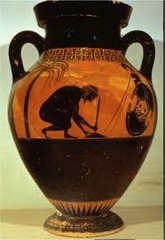
Ajax committing suicide, Black Figure, Geometric Orientalizing, Bologne

answer
Movement of creating more emotion from the audience. (the moment before something is about to happen)...starts of with simple object like he geometric vase (they are recovering), black figure wear, ajax committing suicide...pathos...simpler compositions, single or two figures...psychological sensitivity...what is greek identity??—more naturalism
question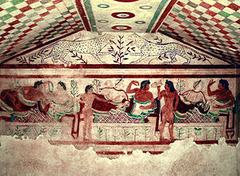
Tomb of the Leopards, Etruscan, Italy

answer
beautiful tombs paintings
question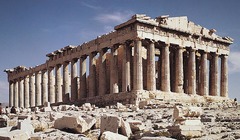
Parthenon, Classical, Athens, Greece

answer
parthenon is the masterpiece of greek architecture...symmetric ideal greek temple
question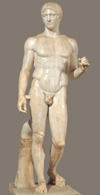
Polykleitos Doryphoros, classical, Naples Museum

answer
detail, blood rushing to hand, marble (weight shift)
question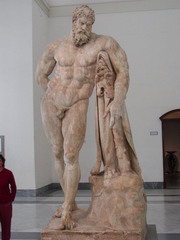
Weary Herakles, Late classical, Naples Museum

answer
stoic emotion, but very realistic features, weight shift
question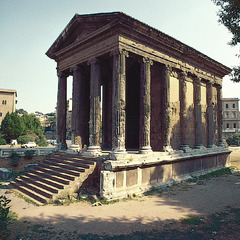
Temple of Fortuna Virilis, Hellenistic, Rome

answer
Severe, Classical ; Hellenistic Periods

